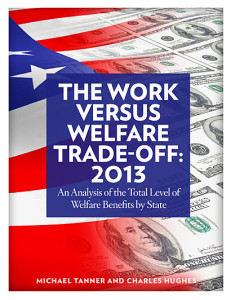 In Maryland work versus welfare is losing out. With some of the most generous welfare benefits in the country, there are powerful incentives not to get a job.
In Maryland work versus welfare is losing out. With some of the most generous welfare benefits in the country, there are powerful incentives not to get a job.
Aug 31, 2015 – Maryland Welfare Benefits Better Than Most European Countries – Rptr
Click on the Cato Institute report “The Work Versus Welfare Tradeoff 2013”
“In Maryland, a mother with two children participating in seven major welfare programs (Temporary Assistance for Needy Families, Medicaid, food stamps, WIC, housing assistance, utility assistance, and free commodities), could receive a package of benefits worth $35,672, the 10th highest in the nation. Only Hawaii, Massachusetts, Connecticut, New Jersey, Rhode Island, New York, Vermont, New Hampshire and the District of Columbia provided more generous benefits.” Michael Tanner, Report Author
If a mother of two participating in available Maryland programs can earn $35,672 on welfare, she would have to earn at least $62,000 to make the same effective income after taxes and daycare. So why work? As generous as the benefits are, the State does little to guarantee that taxpayer money is going to the truly deserving. Independent and federal audits have shown that Maryland is among the worst states in enforcing qualifications and limitations on its welfare payments.
_____________________________________________________________
In Maryland It Pays Not To Work
By Michael Tanner, Baltimore Sun
Contrary to stereotypes, there is no evidence that people on welfare are lazy. Indeed, surveys of welfare recipients consistently show their desire for a job. However, there is also evidence that many are reluctant to accept available employment opportunities. In fact, despite the work requirements included in the 1996 welfare reform, less than 13 percent of adult welfare recipients in Maryland are working in unsubsidized jobs, while roughly 45 percent are involved in the broader definition of work participation, which includes activities like job search and training.
Perhaps that is because, while poor people are not lazy, they are not stupid either. If you pay people more not to work than they can earn by working, many will choose not to work. And Maryland pays people on welfare a great deal not to work.
A new study released by the Cato Institute looks at the state-by-state value of welfare. Nationwide, our study found that the value of benefits for a typical recipient family ranged from a high of $49,175 in Hawaii to a low of $16,984 in Mississippi.
In Maryland, a mother with two children participating in seven major welfare programs (Temporary Assistance for Needy Families, Medicaid, food stamps, WIC, housing assistance, utility assistance, and free commodities), could receive a package of benefits worth $35,672, the 10th highest in the nation. Only Hawaii, Massachusetts, Connecticut, New Jersey, Rhode Island, New York, Vermont, New Hampshire and the District of Columbia provided more generous benefits.
It is important to remember that welfare benefits are not taxed, while wages are. In fact, in some ways, the highest marginal tax rates anywhere are not for millionaires, but for someone leaving welfare and taking a job.
The earned income tax credit and child tax credit have gone some way to address this wedge between welfare and work, but significant deterrents to work still remain. Even after accounting for the effects of these tax credits, a mother with two children in Maryland would still have to earn $18.35 per hour for her family to be better off than they would be on welfare.
To put that in perspective, that is more than the average entry level salary for a teacher or secretary. In fact, it is more than 94 percent of Maryland’s median salary.
Don’t forget that there are additional costs associated with going to work, such as child care, transportation and clothing. And, of course, even if the final income level remains unchanged, an individual moving from welfare to work will perceive some form of loss: a reduction in leisure as opposed to work.
By not working, welfare recipients are simply responding rationally to the incentive systems our public policy makers have established for them.
Of course, not every welfare recipient meets the study’s profile, and many who do don’t receive all the benefits listed. (On the other hand, some receive even more.) Still, what is undeniable is that for many recipients — particularly “long-term” dependents — welfare pays substantially more than an entry level job.
This makes sense for recipients in the short term, but it may hurt them over the long term. One of the most important steps toward avoiding or getting out of poverty is a job. Only 2.6 percent of full-time workers are poor, compared with 23.9 percent of adults who do not work. Many anti-poverty activists decry low-wage jobs, but even starting at a minimum wage job can be a springboard out of poverty.
There should clearly be a public policy preference for work over welfare. And while it would be nice to raise the wages of entry level service workers, government has no ability to do so. (Study after study shows that mandated wage increases result in increased unemployment for the lowest skilled workers).
Therefore, if Congress and state legislatures are serious about reducing welfare dependence and rewarding work, they should consider strengthening welfare work requirements, removing exemptions and narrowing the definition of work. In particular, legislators in Maryland should consider ways to shrink the gap between the value of welfare and work by reducing current benefit levels and tightening eligibility requirements.












